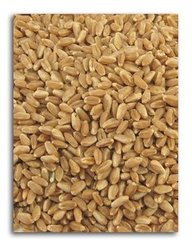
Hard red spring wheat -- grown mostly in North Dakota, Montana, South Dakota and Minnesota -- stands out as the aristocrat of wheat for baking bread. Hard red spring has the highest protein content of all U.S. wheats (usually 13 to 16 percent) which, in turn, corresponds with greater gluten content. The addition of hard red spring improves dough handling and mixing characteristics, and water absorption. Hard red spring wheat is a specialty wheat because of its high protein content and strong gluten characteristics. Some of the world's finest yeast breads, hard rolls and bagels are made with hard red spring.
Spring Wheat vs Winter Wheat
There is a difference between spring hard red wheat and winter hard red wheat. The difference has to do with the time of planting. Spring hard red is planted in the spring and grows thru the summer and is harvested in the fall. Winter hard red is planted in the fall, grows until frost then is dormant throughout the winter and again grows in the early spring to be harvested late spring. The starting and stopping of the winter hard red berries causes the protein of the berry to be less, than in the spring wheat. If you are purchasing wheat berries to mill always buy the spring hard red, it's a bit more expensive but worth the extra cost for the extra nutrition.
Basic Nutrient Values
Regardless of the variety, wheat berries are high in carbohydrates and dietary fiber, as well as vitamins and minerals. Protein content varies somewhat. A normal serving of wheat berries is 1/4 cup dry which, when cooked, yields 1/2-cup serving. According to ELook.org, a 50g serving of hard red wheat berries, or about 1/4 cup uncooked, provides 163.5 calories, 1g of fat, 6.5g of protein, 35.5g of carbohydrates, 6g of dietary fiber and 1mg of sodium. Wheat berries are rich in vitamins B1 and B3; and the minerals magnesium, phosphorus, copper, manganese and selenium.
Significance of Wheat Berry Micro-nutrients
B vitamins are important for a healthy nervous system and energy metabolism; magnesium along with phosphorus is essential for regulating blood pressure and building strong, healthy bones. Phosphorus is also needed to form part of DNA and RNA, activate some proteins in the body and store and transport energy. Copper is needed to form connective tissue, blood cells and promote function of the nervous, immune and cardiovascular systems. Manganese aids in bone formation and the metabolism of carbohydrates and proteins while selenium supports immune system and thyroid gland function.
Health Benefits
Wheat berries, like most whole grains, are an excellent source of dietary fiber -- which promotes digestive health; helps lower blood cholesterol and blood sugar levels; aids in weight management and encourages regular bowel movements, according to MayoClinic.com. The Harvard School of Public Health reports that whole grains, such as wheat berries, contain plant estrogens or phytoestrogens that may reduce your risk of developing certain types of cancers -- particularly in conjunction with minerals found in whole wheat -- such as magnesium, selenium, copper, and manganese.
Spring Wheat vs Winter Wheat
There is a difference between spring hard red wheat and winter hard red wheat. The difference has to do with the time of planting. Spring hard red is planted in the spring and grows thru the summer and is harvested in the fall. Winter hard red is planted in the fall, grows until frost then is dormant throughout the winter and again grows in the early spring to be harvested late spring. The starting and stopping of the winter hard red berries causes the protein of the berry to be less, than in the spring wheat. If you are purchasing wheat berries to mill always buy the spring hard red, it's a bit more expensive but worth the extra cost for the extra nutrition.
Basic Nutrient Values
Regardless of the variety, wheat berries are high in carbohydrates and dietary fiber, as well as vitamins and minerals. Protein content varies somewhat. A normal serving of wheat berries is 1/4 cup dry which, when cooked, yields 1/2-cup serving. According to ELook.org, a 50g serving of hard red wheat berries, or about 1/4 cup uncooked, provides 163.5 calories, 1g of fat, 6.5g of protein, 35.5g of carbohydrates, 6g of dietary fiber and 1mg of sodium. Wheat berries are rich in vitamins B1 and B3; and the minerals magnesium, phosphorus, copper, manganese and selenium.
Significance of Wheat Berry Micro-nutrients
B vitamins are important for a healthy nervous system and energy metabolism; magnesium along with phosphorus is essential for regulating blood pressure and building strong, healthy bones. Phosphorus is also needed to form part of DNA and RNA, activate some proteins in the body and store and transport energy. Copper is needed to form connective tissue, blood cells and promote function of the nervous, immune and cardiovascular systems. Manganese aids in bone formation and the metabolism of carbohydrates and proteins while selenium supports immune system and thyroid gland function.
Health Benefits
Wheat berries, like most whole grains, are an excellent source of dietary fiber -- which promotes digestive health; helps lower blood cholesterol and blood sugar levels; aids in weight management and encourages regular bowel movements, according to MayoClinic.com. The Harvard School of Public Health reports that whole grains, such as wheat berries, contain plant estrogens or phytoestrogens that may reduce your risk of developing certain types of cancers -- particularly in conjunction with minerals found in whole wheat -- such as magnesium, selenium, copper, and manganese.
 RSS Feed
RSS Feed
